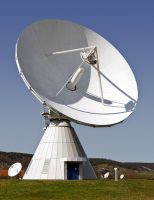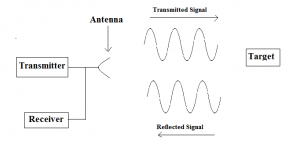Table of Contents
Radar
This is all about the Introduction of Radar. The full form of Radar is Radio Detection and Ranging. The term Radio alludes to the utilization of electromagnetic waves with wavelengths in the purported radio wave segment of the range, which covers a wide range from 104 km to 1 cm.
Radar is an electromagnetic framework for the identification and position of targets. It works by transmitting a specific type of waveform, for example, a sine wave or cosine wave, and identify the nature of receiving the reflected signal. By analyzing the reflected signal, the target can be located and sometimes identified. It is utilized to expand the ability of one’s faculties for watching the earth, particularly the feeling of vision. A basic type of radar containing a radio transmitting antenna, to transmitting the electromagnetic waves, a receiving antenna, which used to receive or catch the reflected waves, and a signal analyzing section, which analyzes the received reflected waves. It transmits the electromagnetic energy pulse and reflected from the target. A small portion of the energy is reflected back and reached the receiving antenna.
The returned energy is called ECHO, just as it is in sound terminology. This echo is useful to identify the direction and the position of the target. The distance of the target is dictated by estimating the time taken for the radar echo to travel to the target and return back. The basic principle behind the operation of radar is the Doppler Effect, which states that ” When wave energy like sound or radio waves travel from two objects, the wavelength can seem to be changed if one or both of them are moving. This is called the Doppler effect.”
History
In 1887 the German physicist Heinrich Hertz Began trying different things with radio waves in his research facility. He found that radio waves could be transmitted through some materials, and reflected by others. Some years later a German engineer, Christian Huelsmeyer, proposed the use of radio echos to avoid collisions in marine navigation. The invention of modern radar is generally credited to Sir Robert Waston-Watt. Nikola Tesla, in August 1917, first settled standards in regards to recurrence and power level for the main crude radar units. Prior to the Second World War, improvements by the Americans, the Germans, the French, the Soviets, and the British prompted the cutting edge rendition of the radar.
Working Principle of Radar
A radar setup has a transmitter that produces radio waves called radar signals in the direction of moving or stationary targets. When these radar signals strike or collide on the target surface, they will be reflected or dissipated in various directions. Radar signals are reflected properly by materials of significant electrical conductivity particularly by most metals, via seawater and by wet ground. A portion of these makes the utilization of radar altimeters conceivable. The radar signals that are reflected back towards the receiver are the essential ones for the working of radar. With the help of these reflected signals, it can be identified that the target is moving either towards or away from the radar, because there is an approximately equal change in the frequency of the reflected back signal, due to the Doppler effect.
The setup of the radar is given in the figure. An electromagnetic signal is transmitted by the transmitter and this transmitting signal is transmitted in space with the help of an antenna. Some portion of the transmitted signal is reflected back by the target surface towards the radar. After the analysis of this reflected signal the position, distance and direction of the targets can be identified. Due to this working system radar’s full form is radio detection and ranging. This is basically the Introduction of Radar.
Radar Frequencies
In the microwave region of the EM spectrum radar is operated, and the energy is emitted in the form of an EM wave into the atmosphere through an antenna. A great deal of information is provided with only a fraction of the energy returned. This entire process occurred at the speed of light. When the targets are struck by EM energy, the signals return from these targets which are called radar echoes. The figure shown below shows the different types of EM waves as a function of frequency, from EM telegraphy to gamma rays. Although all of them are EM waves, some of their characteristics are very different depending on their frequency. Radars operate in the range of 3 MHz to 300 GHz, though the large majority operate between about 300 MHz and 35 GHz.
Classification of Radars Based on Waveforms Used
Radars can be classified into two groups depending upon the type of waveforms radiated.
CW radars are of two types:
– CW radar (Doppler radar) – uses unmodulated waveforms for radar transmission and
– FMCW radar – uses frequency-modulated waveforms for radar transmission
Pulsed radar uses pulse modulated waveforms for radar transmission.Each type of waveform enjoys distinct advantages and has specific usage.
CW radars:
The simplest type of radar is the Continuous Wave (CW) radar, which uses a continuous waveform for its transmission. These radars are capable of detecting moving targets as well as their radial velocities. Their main disadvantages are their inability to find the range of the targets.
FMCW radars:
This is an improved version of the CW radar, and it can measure the range of targets by the use of frequency-modulated signals. They are usually used in radio altimeters for finding the height of an aircraft.
Pulsed radars:
The most widely used radar is the pulsed radar, which uses pulse-modulated microwave signals for their transmission. The pulsed radars can be designed either for moving target detection or for radial velocity measurements.
Advantages
- It can see through darkness, haze, fog, rain, and snow.
- They can determine the range and angle i.e. the location of the target very accurately.
Limitations
- It cannot resolve in detail like the human eye, especially at a short distance.
- They cannot recognize the color of the target.
Application
Civilian applications
- Navigational aid on ground and sea (navigation is not affected by poor visibility or darkness) or long-distance commercial aircraft in the air by transmitting short waves.
- Its altimeters can determine the height of the plane above ground.
- Its blind Lander for aiding aircraft to land under poor visibility, at night, under adverse weather conditions, etc.
- Police radars for directing and detecting speeding vehicles.
- They can be determining the speed of moving targets, (e.g. the speed of a cricket ball being bowled) automobiles, shells, guided missiles, etc.
- In ATC they are used at airports to identify all aircraft, they are either coming towards or going away from the airport.
- Its Airborne type is used for satellite surveillance.
Military applications
- Detection and ranging of enemy targets even at night.
- Aiming guns at aircraft and ships.
- Bombing ships, aircraft or cities even during overcast or at night.
- Early warning regarding approaching aircraft or ships.
- Directing guided missiles.
- Searching for submarines, landmasses, and buoys.
Related Post:





